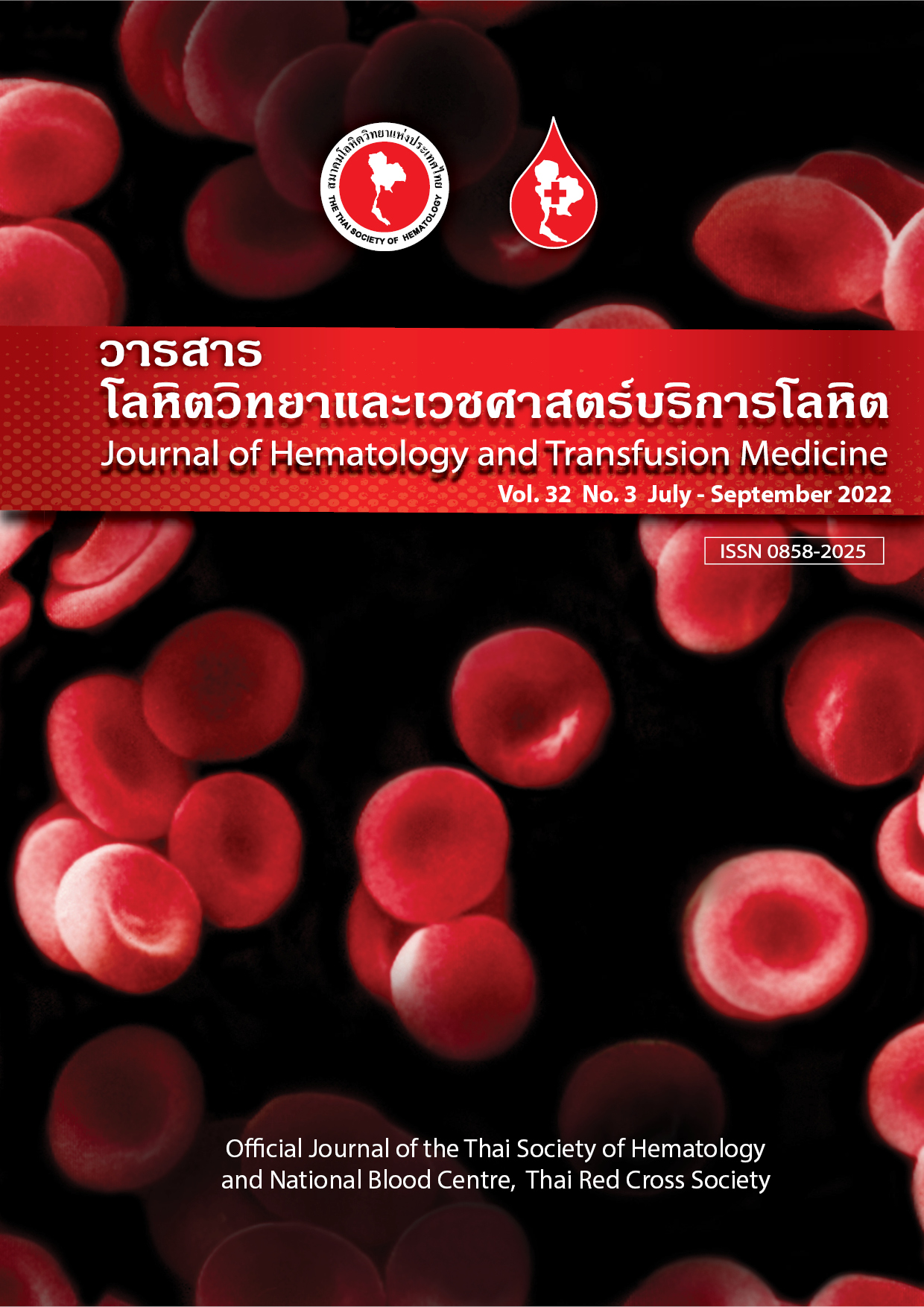Pharmacokinetics of recombinant factor VIII among pediatric patients with hemophilia A, a multicenter study in Thailand
Keywords:
Pharmacokinetic, pediatric, hemophilia, recombinant factor VIIIAbstract
Background: Recombinant FVIII (rFVIII), the synthetic recombinant antihemophilic factor VIII, was developed due
to concern of adverse effects of plasma derived products. In Thailand, the number of children with hemophilia
A (HA) treated with rFVIII has gradually increased. However, related pharmacokinetic studies on rFVIII are
mostly conducted among adults and few studies in a Thai pediatric population. Objectives: This study aimed to
evaluate the pharmacokinetic parameters of standard half-life (SHL) rFVIII and identify the correlation between
pharmacokinetic parameters and baseline characteristics among children with HA. Methods: A prospective
multicenter cohort study was conducted. Pediatric patients with severe HA treated at King Chulalongkorn Memorial
Hospital, Prapokklao and Sawanpracharak Hospitals were enrolled. Factor VIII activity was measured by
validated one stage clotting assay before and at 0.25, 0.5, 1, 12 and 24 hours after a single dose of Recombinate®
infusion (50±5 units per kilogram). Results: Thirteen patients with severe HA treated and had regular follow-up
were enrolled. Pharmacokinetic parameters revealed mean percentage of maximum FVIII of 84.55 U/dL, volume
of distribution of 66.35 mL/kg, half-life of 8.53 hours, clearance of 5.49 mL/hr/kg, AUC0-24 of 777.93 U.hr/dL and
AUC of 928.01 U.hr/dL. The results showed statistically significant correlation between dose per kilogram and
maximum concentration (p-value = 0.002). We also observed the trend of dose per kilogram and AUC0-24 correlation (p-value = 0.057). Conclusion: Our study reported concerning the pharmacokinetic parameters of recombinant FVIII in a Thai pediatric population and also showed variation among different studies.
Downloads
References
Srivastava A, Santagostino E, Dougall A, Kitchen S, Sutherland M, Pipe SW, et al. WFH Guidelines for the Management of Hemophilia, 3rd edition. Haemophilia.2020;26:1-158.
Llinás A. Haemophilic arthropathy. Haemophilia.2010;16:121.
Chuansumrit A, Mahasandana C, Chinthammitr Y, Pongtanakul B, Laossombat V, Nawarawong W, et al. National survey of patients with hemophilia and other congenital bleeding disorders in Thailand. Southeast Asian J Trop Med Public Health. 2004;35:445-9.
Kaufman RJ, Wasley LC, Dorner AJ. Synthesis, processing, and secretion of recombinant human factor VIII expressed in mammalian cells. J Biol Chem.1988;263:6352-62.
Gomperts E, Lundblad R, Adamson R. The manufacturing process of recombinant factor VIII, recombinate. Transfus Med Rev. 1992;6:247-51.
Kaufman RJ, Wasley LC, Davies MV, Wise RJ, Israel DI, Dorner AJ. Effect of von Willebrand factor coexpression on the synthesis
and secretion of factor VIII in Chinese hamster ovary cells. Mol Cell Biol. 1989;9:1233-42.
The United States Food and Drug Administration. RECOMBINATE [Antihemophilic Factor (Recombinant)] [Internet]. 2022 [cited 2022
Sep 9]. Available from: https://www.fda.gov/media/78282/download
Bray GL, Gomperts ED, Courter S, Gruppo R, Gordon EM, Manco-Johnson M, et al. A multicenter study of recombinant factor VIII (Recombinate®): safety, efficacy, and inhibitor risk in previously untreated patients with hemophilia A. The Recombinate Study Group. Blood. 1994;83:2428-35.
Ewenstein BM, Gomperts ED, Pearson S, O’Banion ME. Inhibitor development in patients receiving recombinant factor VIII (Recombinate rAHF/Bioclate): a prospective pharmacovigilance study. Haemophilia. 2004;10:491-8.
White GC 2nd, McMillan CW, Kingdon HS, Shoemaker CB. Use of recombinant antihemophilic factor in the treatment of two patients with classic hemophilia. N Engl J Med. 1989;320:166-70.
Lee CA, Owens D, Bray G, Giangrande P, Collins P, Hay C, et al. Pharmacokinetics of recombinant factor VIII (recombinate) using
one-stage clotting and chromogenic factor VIII assay. Thromb Haemost. 1999;82:1644-7.
Chen ZP, Li PJ, Li G, Tang L, Zhen YZ, Wu XY, et al. Pharmacokinetic Studies of Factor VIII in Chinese Boys with Severe Hemophilia A: A Single-Center Study. Chin Med J. 2018;131:1780-5
Downloads
Published
Issue
Section
License
Copyright (c) 2022 Journal of Hematology and Transfusion Medicine

This work is licensed under a Creative Commons Attribution-NonCommercial-NoDerivatives 4.0 International License.



